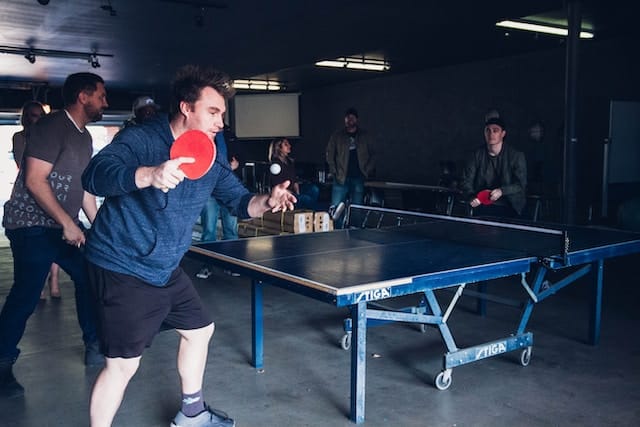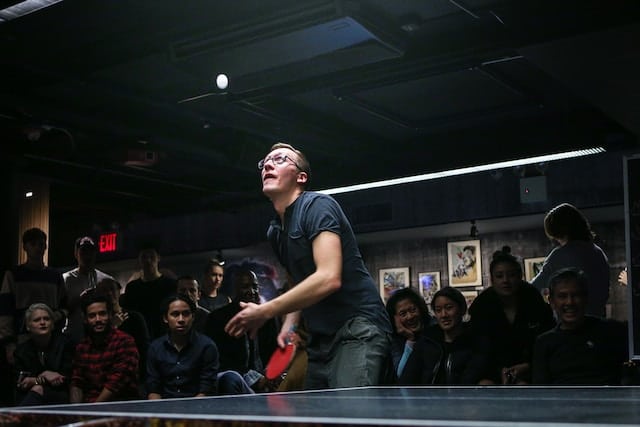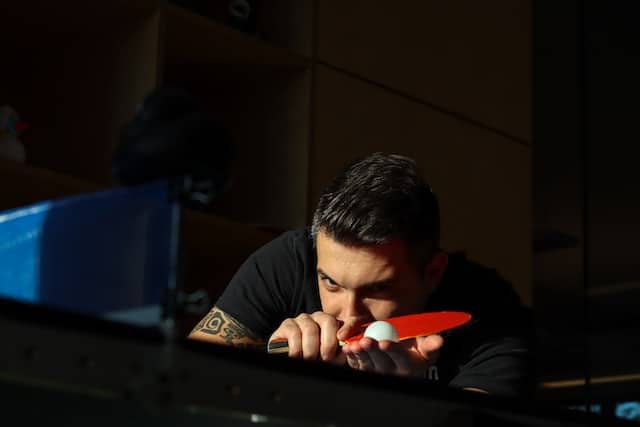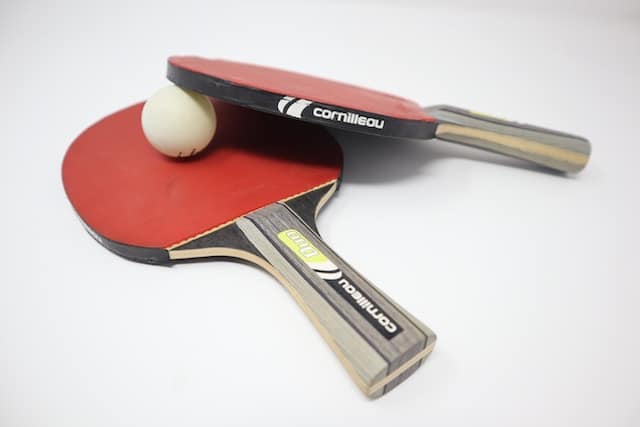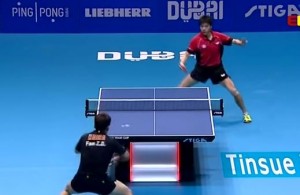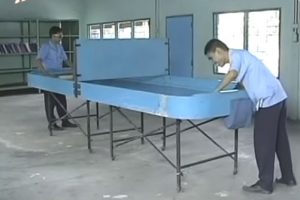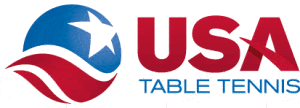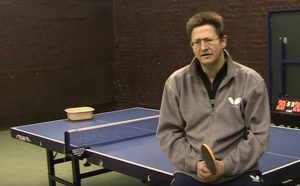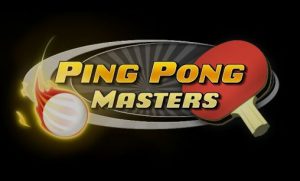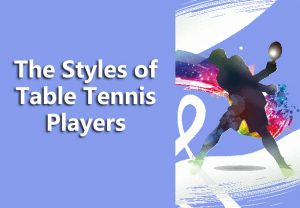Table tennis is a fairly simple game to understand and play — simply hit the ball onto your opponent’s side until you or they miss. Easy enough. Yet there’s one area of table tennis with more rules and restrictions, and that’s serving.
You can’t simply play the ball straight out of your hand as you may expect. It violates the rules. Unfortunately, many beginners are unaware of these rules and this leads to widespread illegal serving. Nobody wants to break the rules, so get in the know!
In this post, I detail and explain the 6 key ping pong serving rules you need to understand and follow.
Table of Contents
ToggleThe 6 Ping Pong Serving Rules You Need to Follow
1. Serve Behind the End Line
You’ve all done it, I’m sure. Quickly rushing around the side of the table to play an abrupt short serve close to the net before your opponent has time to realize what is happening. Unfortunately, this is highly illegal.
All serves must take place behind the end line of the table. This applies both to your throw of the ball and your contact with it.
2. Throw the Ball From an Open Palm
Throwing the Ball
The biggest serving sin you see in table tennis is players not throwing the ball up before serving. This is mostly because beginners believe tosses are a flashy act rather than a required one. What’s more, many beginners cannot serve consistently when throwing the ball up.
In any case, to adhere to the ping pong serve rules, you must throw the ball at least 16 cm before you make contact with it. For whatever reason, people visualize this as more than it actually is. Think of a small 15 cm ruler, it’s only 1 cm more than that! So you really don’t have to throw the ball very high.
Most seasoned players throw the ball up far higher than this. This is because with a higher toss comes the possibility of more spin.
Having an Open Palm
Besides throwing the ball up, you must also ensure your palm is open. This means you can’t throw it using your fingers — another common serving mistake.
The reason for this is that in the 1930s many professional players used to spin the ball with their fingers as they threw it up. As a result, they were able to produce more spin when they made contact with the ball. The rules were soon changed to combat this strategy.
I wouldn’t focus too much on having a completely flat palm, in fact, I advise against it. It reduces your control for the throw. Instead, slightly cup the ball in your palm to keep it secure. As long as your hand is not too curved, you will not be pulled up. Umpires are focused on ensuring no spin is produced with your fingers, not how curved your hand is.
3. Throw the Ball Straight Up
Besides throwing the ball up 16 cm, you also need to throw it up straight, or “Near vertically” as the rules put it.
Doing this is rather simple, so you shouldn’t have much issue with it. Of course, the phrase “Near vertically” is a little ambiguous. We don’t have exact measurements to work with here, so it’s somewhat open to interpretation.
What we’re looking for in illegal serves with this rule, are those where the server throws the ball backward toward their racket. The reason for this is that it helps increase the spin on the ball.
As long as you are throwing it fairly straight, I highly doubt an umpire will call you up on your toss. But remember, the higher you toss the ball, the more obvious the trajectory becomes. So if you’re having trouble, try throwing the ball lower. Also, be sure to strike the ball in its descending portion rather than its ascending portion. The serving rules for ping pong are quite clear on this, so if you strike the ball as it is rising you may receive a warning or point deduction.
Read More: Table Tennis Rules for Blind Players
4. Do Not Obscure the Ball From Your Opponent
For me and many others, this is the most important rule when it comes to serving. As you likely already know, serves are all about spin. And if your opponent hides their serve with their arm or shoulder, you can’t see what spin they put on the ball.
This makes it VERY difficult to return the serve.
While it’s true you also have to throw the ball from above the table’s surface, it’s purposeful ball hiding with one’s body that is more troublesome to deal with. This is because the former hides the toss point which doesn’t affect the difficulty of returning the serve all that much. Contact with the ball is far more important.
This rule hasn’t always been around, but it has been in place for a while. It came into effect in 2003 to make serves easier to return. And I’m happy it did. Quality serves are tough enough to handle as it is, having the ball obscured from view is simply a nightmare!
So when serving make sure you don’t hide the ball from your opponent, and also, you need to ensure the umpire can see the ball throughout the entire service as well.
5. Make Contact With Both Sides of the Table
Now we come to the service rule you probably already know: the ball needs to land on both sides of the table. First, you have to strike it onto your side and then your opponent’s side. You can hit the ball anywhere on the table, so try to experiment with placement to give your opponent trouble.
It’s only doubles where you have placement restrictions. For these games, you have to serve diagonally from the right side of the court to the opposing right side.
6. No Second Serves!
Like many other racket sports, you don’t get second serves in table tennis, so you need to make them count. Consistency trumps all! So practice your serves often in training to ensure you’re not missing them during matches.
Also, be aware that the ball is considered live as soon as you throw it into the air. This means you can’t catch it if you make a bad throw. As such, try to play your serve even if you make a poor throw.
Of course, there are ping pong rules for let serves too. If the ball contacts the net during the serve but it is otherwise legal, a let occurs. This allows you to re-take your serve.
Be Warned!
While you may get away with breaking the ping pong rules for serves with your friends or at your local club, you might not be so lucky in an official setting.
The serving rules in ping pong give the umpire the power to scrutinize your serves and award points to your opponent. Therefore, it is essential you abide by the service rules. In the first instance, you will likely receive a warning with no deduction of points. However, thereafter, you will lose a point if you break any rules.
Serving Leniency
Despite the rules encouraging the enforcement of point warnings and point deductions for illegal serves, the reality is that players frequently get away with performing illegal serves. It’s an unfortunate reality and one of the few aspects of the sport that I’m not a fan of.
We see it constantly at a professional level, so it is no wonder that umpires are reluctant to enforce it at a local league level for example. Nevertheless, I advise you to stick to the rules and exercise good sportsmanship.
Fairness is key for enjoyment. Even though you might be able to get away with serving incorrectly, put yourself in the shoes of your opponent. It’s not very fun, is it? What’s more, it hurts your image as a player. Not only are you playing in an inconsiderate way, but you may also appear to be at a lower level than you actually are.
Read More: How to Play Beer Pong: Rules, Tips, & Equipment
Closing Thoughts
Most beginners are ignorant of ping pong serving rules and break them. However, they are not very difficult to get your head around. At its most basic level, keep your serves behind the back line, throw the ball straight up ≥16cm from an open palm, and without hiding the ball, make contact with both sides of the table.
After a session or two, you should comfortably have these rules down and you’ll be a better player for it.
Enjoy this article? Learn about the rest of the rules by reading our ping pong rule guide.
Frequently Asked Questions
What Is the First Serve Rule in Ping Pong?
The first server is decided at random. Traditional this is via a coin toss, however, players may also hide the ball in one hand and have you guess. Another way is to ask you to call “odd or even” before randomly turning over a portion of numbers on the scoreboard.
What Are the Ping Pong Rules on How to Serve?
The rules require you to serve behind the backline and throw the ball up from an open palm near vertically at least 16 cm. You must then strike the ball as it is descending and hit both your and your opponent’s side of the table. The ball must also remain in full view of the opponent and umpire at all times.
Do You Have to Serve Off the Back in Ping Pong?
You must always serve behind the end line. However, you can serve anywhere on the table provided you are not playing doubles.
Are You Allowed to Spin on a Serve in Ping Pong?
You can spin the ball however you like with your racket when serving. The only type of spin you can’t produce is with your throwing hand. This means you must serve from an open palm rather than from your fingers.
Do You Have to Serve to Score in Ping Pong?
You do not have to be serving to score in ping pong. You can win points when your opponent is serving.
Do You Get 2 Serves in Ping Pong?
You get 2 serves in ping pong before it switches to your opponent. The only time this changes is when the score reaches 10-10. At this point, each player only receives 1 serve until a player has a 2-point lead at which point they have secured the game.
Can You Lose on a Missed Serve in Ping Pong?
If you fail to hit the ball onto your side of the table and then your opponent’s side you lose a point.
What Is an Illegal Serve in Ping Pong?
An illegal serve is any type of serve that breaks the rules. This includes:
- Not serving behind the end line
- Not throwing the ball up 16 cm or more
- Striking the ball as it is rising
- Closing your hand around the ball
- Obscuring the ball from your opponent or the umpire
- Not making contact with both sides of the table
- Missing the ball altogether

